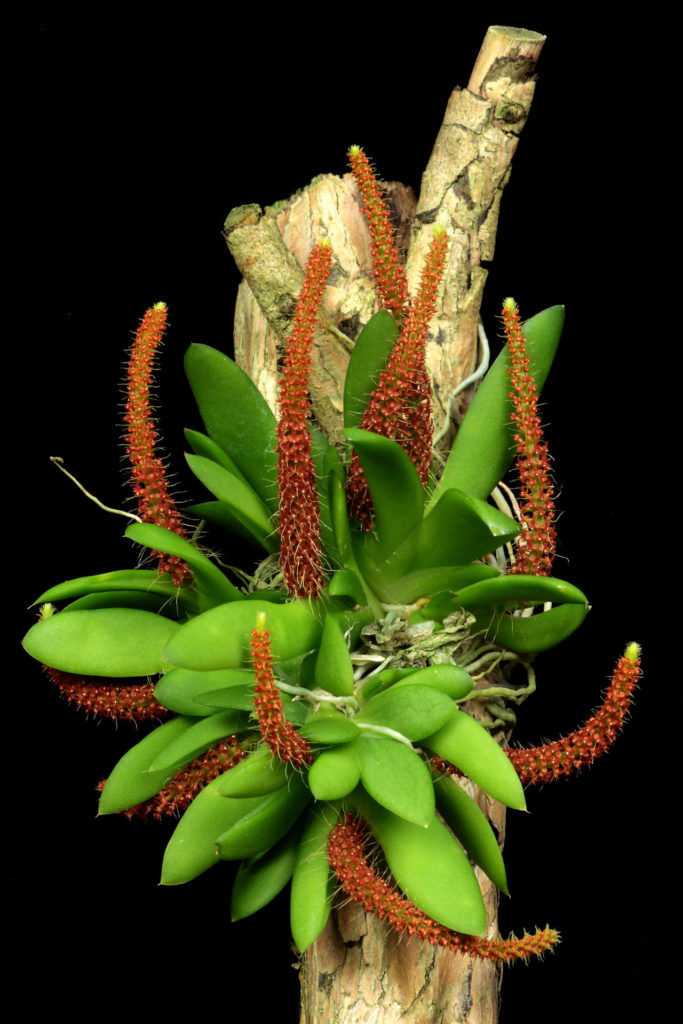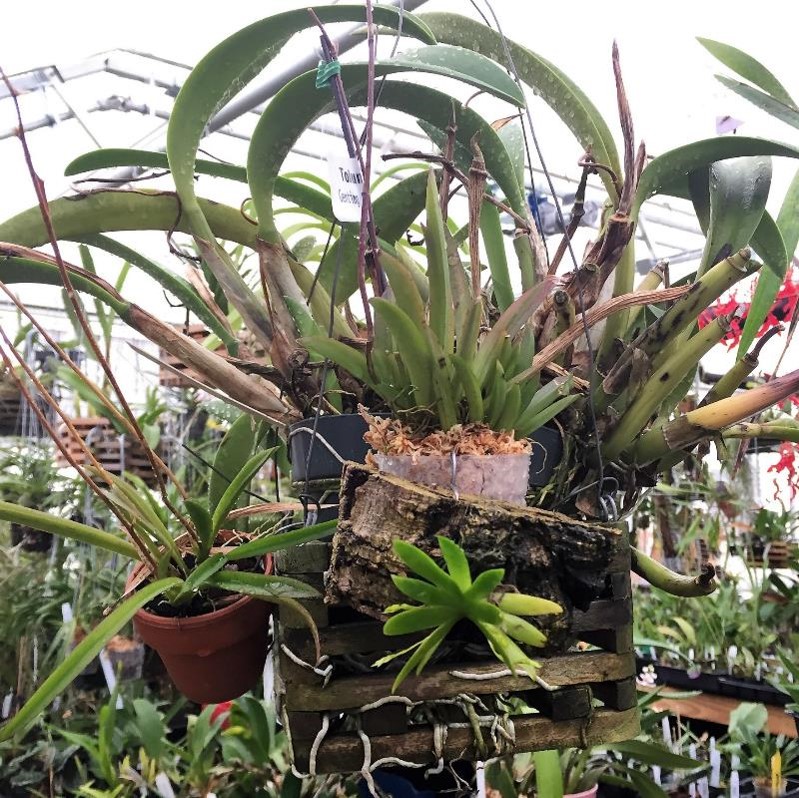Last night I was speaking to the Marin County Orchid Society via Zoom, and I had a question about mounted plants that I think should be shared with anyone interested in miniatures. The question has multiple parts so I will tackle the parts separately.

Dendrobium subuliferum 
Oberonia rufilabris (from AOS.org) 
Gastrochilus patinatus; photo by Bryon Rinke
Why would I mount an orchid?
Most orchids are “mounted” in their natural environment. Their roots are attached to a larger plant or a rock, and they are perfectly happy. Many live in areas with high humidity and frequent rain for at least part of the year. The bare roots get soaked and then dry out on a daily basis. That fast wet-dry-wet-dry cycle makes for very happy roots. When you pot an orchid, you are slowing the wet-dry cycle which makes for easier care (i.e., less frequent watering). Most orchids are perfectly happy with this arrangement, and those orchids that prefer constant moisture (like bulbos and pleurothallids) may prefer a pot. Some, however, really suffer with prolonged dampness.

Don’t you have to water a lot more?
Usually, yes. Without a pot and media surrounding the roots, plants are definitely going to dry out faster. To water, you can mist, dip/soak, or run the mount under water. In warmer weather I water my mounted orchids every day; in cooler weather I can water every couple days, especially when it’s cloudy. Winter may actually be a drier time of year for you because of the drying effect of your heating system. You would then need to water every day.
If you are too busy to water every day but you really want to have mounted orchids, consider a terrarium. Terrariums can be as small as a jar or candy dish or as big as a fish tank (or bigger if you go whole hog). Terrariums create a more humid environment that, when closed, can keep your orchids from needing to watered for weeks or months! Talk about low maintenance… A good holiday solution for mounted orchids is a ziplock bag or some other closed container (again, like a terrarium) for temporary moisture preservation. I have grown small orchids in a ziplock for a year without doing a thing (please do not call the police). Does it look pretty? No. Does it preserve your orchids till you get home? Yes.

How can you know what the plant will prefer?
There is a ton of information available on the internet regarding orchids. When I get a new species and I don’t know if he should be mounted or potted, I go to Google Images. I look at the pictures and see if most people mount or pot it–simple! Talk about scientific… Sometimes I see it both ways and decide which I think most customers would prefer.
Sometimes the orchid’s inflorescence determines the best way to grow the plant. Plants like Leptotes and Gastrochilus can be grown in a pot, but because their flowers are pendant on very short pedicels, they are shown off much better on a mount. Similarly, I had some Oberonia growing and blooming like mad in the tiny pots I had purchased them in, but the flower spikes were kinda wonky because they were growing up and over rather than out and down.

Where do I hang the mounts?
Because mounted plants are generally hung up somewhere, this is the most basic of important questions! Where will I hang it? In the greenhouse I often hang my mounted guys off of larger pots and baskets. If you are growing any kind of plant in a pot, you can do the same. Alternatively, you can buy suction cup hooks or “Command” hooks to attach to a window or glass door.

Finally, it’s safety first when growing orchids–safety of the orchid’s life! If you KNOW you can’t water every day and you don’t have a terrarium, do not go for the mounted guys. There are other orchids for you! This is not a short-coming on your part, just practicality. If you want to try one to see how it goes, choose an orchid that enjoys being dry like a Dendrobium or Cattleya. If that goes well, try a Bulbophyllum (they like moisture but are VERY forgiving of drying out), and then you can tackle the REAL moisture lovers like pleurothallids.
Enjoy your orchids however you grow them. If you are happy growing them, they will be happy growers.

Leptotes bohnkiana (Cattleya Alliance) 
Dendrobium greguglus 
Bulbophyllum thaiorum

Can we take a step beyond potted or mounted? I have several Bulbophyllums. My question is about how to discover if a plant prefers to grow horizontally or vertically. Some plants are said to grow “on trunks,” which would seem a vertical preference. I have been growing a Bulb lobbii hanging on a cork slab for many years and it does well this way. I grew a Bulb frostii mounted and hanging for several years and it did not do well until I laid it down to let it grow horizontally, same water, heat, light and now it does fine. My Bulb electinum has been doing nothing at all in a pot, so yesterday I mounted it on a cork slab and put it in a vertical orientation. Several others – falcatum, makoyanum, lasiochilum – all seem to be doing well in shallow pots in bark.
Growing them in shallow pots seems to replicate horizontal growth, while hanging a mounted plant seems to replicate vertical growth. Have you got any suggestions about how to tell which direction might be better for any particular species (of Bulb or any other genus, really) other than this long and tedious and unproductive trial and error?
Wow, that’s a really good question. I think it all boils down to how wet a species likes to be. Although Bulbos do like moisture, in my experience, some definitely like to be wetter than others. Bill Thoms, the acknowledged expert on Bulbos, says that all the mounted Bulbos should be grown horizontally. You can accept that as the answer, and then experiment from there. A number of my larger-bulbed guys seem happiest when they have grown out of the pot and are growing mostly bare root (i.e., most like a vertical mount). I’d like to have a pat answer about big vs. small, but I have a bunch of small mounted guys that are super happy (all my mounts are vertical for space reasons). Given the size of the genus, I suppose we shouldn’t be surprised that not everybody is the same. If you have the space, perhaps the best answer is to leave everyone horizontal UNLESS they are unhappy that way.
I feel like that was a long answer with a short bottom line, but at least you can see my reasoning. Thanks for the question.